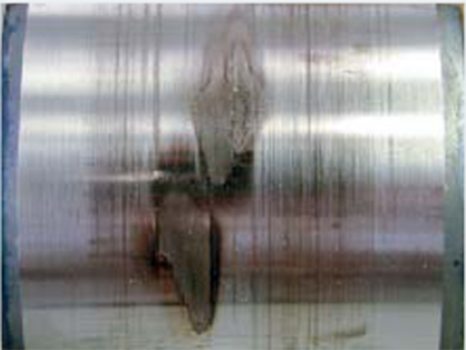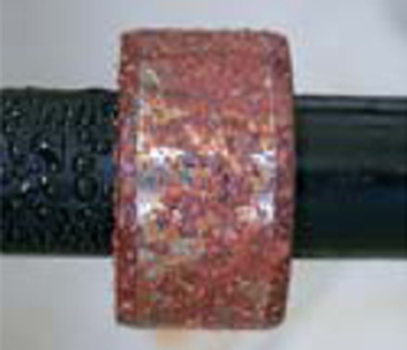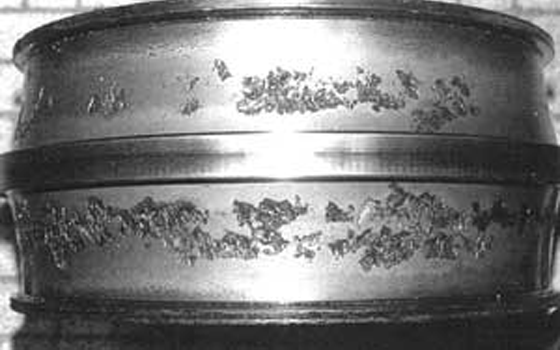What causes machine components to fail? What are the most prevalent failure mechanisms, and how can you avoid them? Continue reading to learn how to spot components in various phases of progressive failure, as well as the tools you may use to diagnose and fix them.

Failure Mechanisms
The most common failure modes in lubricated machines include abrasion, corrosion, fatigue, adhesion, cavitation, erosion, electrical discharge, and deposition.

Abrasion
Hard particles that are too big to flow through a lubricant-lubricated surface cut into another moving surface, causing abrasion. A surge in the circulation system, a faulty breather, or even a faulty engine might cause it to happen.
CBM Tool: Oil Analysis

Corrosion
When a substance (moisture, oxygen, or acids) attacks metal and alters its chemical properties, this is known as corrosion. Shear readily removes the resultant oxide, exposing new metal for long-term oxidation. Process contamination, a coolant leak, or a faulty desiccant breather are some of the possible sources of corrosion.
CBM Tool: Oil analysis

Fatigue
Rolling contact failure occurs often in roller bearings and gears, resulting in material fatigue fractures and spalling. Fatigue can be reduced by reducing dynamic loading caused by imbalance, misalignment, and resonance, as well as by reducing static load and other maintenance measures.
CBM Tool: Vibration Analysis, Ultrasound, Infrared Inspection, Oil Analysis
Lack of Lubrication
When the lubricant coating meant to decrease friction and separate a roller from a race or a journal from a shaft fails due to lack of lubrication, metal-to-metal contact occurs. This mechanism may be avoided if the right lubricant is used at the correct level and the machine is run at the proper speed and load.
CBM Tool: Ultrasound Monitoring
Deposition
Any varnish buildup on a control valve can cause it to block and stick, while fibrous material buildup on a fan can produce unbalance and pose a fire hazard. By recognizing, understanding, and resolving the unique accumulation process, this failure mechanism can be avoided.
CBM Tool: Oil analysis

Misalignment
Misalignment occurs when the driven shaft's (motor) centerline of rotation is not concentric with that of the pump's centerline. The tolerance incorporated into the couplings, on the other hand, only indicates how much misalignment the coupling can tolerate while still transferring power.
CBM Tool: Vibration Analysis
Tension, Compression, and Shear
From incipient to catastrophic failure modes, shear force is almost always a contributing element. Mechanical systems are made to last a long time and do work by applying tension and compression. Shear is a frequent failure element in abrasion, corrosion, fatigue, adhesion, cavitation, erosion, and electrical discharge failure processes.
Predictive Maintenance tools used to detect the failure mechanisms
Vibration analysis, oil analysis, acoustics, infrared or thermal imaging testing (thermography), and motor circuit analysis are some of the predictive maintenance techniques employed in the industry.
Thermographic analysis and infrared analysis
Infrared has the benefit of allowing you to construct temperature maps even from a distance. This method is utilized in the maintenance of heating systems. A thermographic examination may also be used to identify bearing conditions and the electrical condition of a motor.
Infrared thermography can be utilized in applications such as:
- A motor's electrical and mechanical characteristics are being monitored.
- Inspections of bearings (abnormal bearing friction)Refractory insulation is being monitored.
- Locating the levels of gas, liquids, and sludge
Infrared thermography's major goal is to confirm that a piece of machinery is operating normally and to detect anomalous heat patterns within a machine. For asset managers responsible for condition monitoring, utilizing infrared thermography to inspect a piece of mechanical equipment is a huge benefit.
Oil analysis is used to evaluate the condition of a machine and its oil by analyzing viscosity, water content, and the presence of other elements and contaminants. The sample will reveal the consequences of issues such as oil degradation and contamination as a device matures. Before you can predict a breakdown, different particles show a slew of issues. Oil Analysis is best used to detect abrasion, corrosion, adhesion, cavitation, erosion, electrical discharge, and deposition.
Vibration analysis
Vibration analysis is ideal for rotating machinery and equipment including compressors, pumps, and engines. We hook them up to a sensor that can detect movement or acceleration, depending on the situation. The sensor detects sound waves produced by movement, which cause electrical impulses to be generated. Vibration can detect failure modes like broken gears, running outside system parameters, electrical faults, belt issues, and cracked shafts, according to the US National Electrical and Mechanical Engineering Institute (NETEI) in Washington, D.C. The following are some of the advantages of employing vibration analysis to assist with data collection:
- Vibration Analysis has a strong history of reliability.
- The likelihood of failure is easily noticeable.
- Anyone with access to the internet may collect data.
- A portable collecting route may be set up quickly.
- Beyond the most common bearing failure search, vibration analysis has a wide range of applications.
Is predictive maintenance a solution for all?
Predictive maintenance was created to prevent problems but don't be misled. The life of our machines is not infinite. Failures occur, no matter what you do. What matters is that you are aware. This is what predictive maintenance brings you - preparedness. Better preparation means a higher level of safety, more savings, and better planning.
Source: machinerylubrication.com


